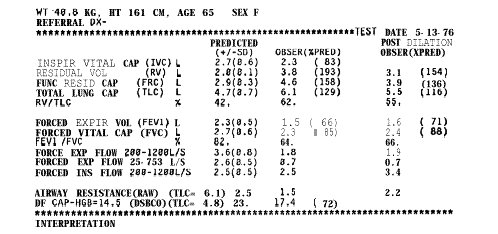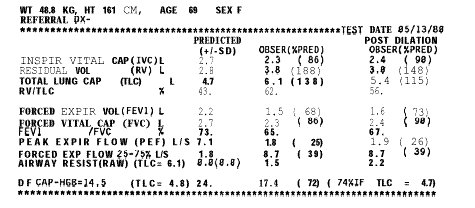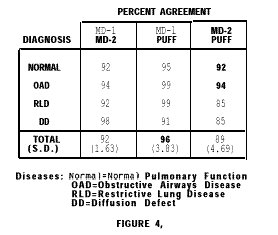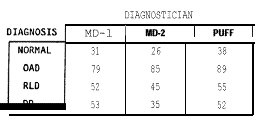
PUFF : an expert system for interpertation of pulmonary function data
Janice S. Aikins, John C. Kunz, Edward H.
Shortliffe
and Robert J. Fallat
CS-TR-82-931
September 1982
Heuristic Programming Project
Departments of Medicine and
Computer Science
Stanford University
실세계에 인공지능기술을 적용하여 약속된 연구결과를 가져왔지만 전문가 영역에서 유용하게 사용되지는 못해왔다. 그러나 DENDRAL, MOLGEN 같은 예외도 있었다. 여기서는 폐기능검사 결과로 나온 데이터를 해석하는 프로그램인 PUFF를 소개하는데 큰병원의 폐기능검사실에서 사용된다. 좀더 나은 성공적인 결과가 나오기에는 몇가지 중요한 한계점이 있어 앞으로 더 많은 연구를 요구한다.
Abstract
The application of Artificial Intelligence techniques to real-world problems has produced promising research results, but seldom has a system become a useful tool in its domain of expertise. Notable exceptions are the DENDRAL [I] and MOLGEN [2] systems. This paper describes PUFF, a program that interprets lung function test data and has become a working tool in the pulmonary physiology lab of a large hospital. Elements of the problem that paved the way for its success are examined, as are significant limitations of the solution that warrant further study.
Researchers in the field of Artificial Intelligence (Al) are just beginning to produce systems that capture the specialized knowledge of experts and that use this knowledge to perform difficult tasks. Although the technology is still rather new, a small set of programs now exist as 뱓ools?useful for building these so-called 밻xpert systems? This paper describes an expert system, called PUFF, which was built using EMYCIN, a generalization of an earlier medical system named MYCIN. The task chosen for PUFF is described briefly, and the rationale for the appropriateness of this choice is presented. PUFF was initially developed on the SUMEX computer, a large research machine at Stanford University, and was later rewritten in a production version to run on the hospital% own mini-computer. We describe here the history of the PUFF project and its current status, including observations about its limitations and successes. We also take a brief look at the knowledge representation and control structure used for the SUMEX version of the system. Finally, the results of a formal evaluation of the production version of PUFF are presented. d
PUFF interprets measurements from respiratory tests administered to patients in the pulmonary (lung) function laboratory, at Pacific Medical Center in San Francisco. The laboratory includes equipment designed to measure the volume of the lungs, the ability of the patient to move air into and out of the lungs, and the ability of the lungs to get oxygen into the blood and carbon dioxide out.?The pulmonary physiologist interprets these measurements in order to determine the presence and severity of lung disease in the patient. An example of such measurements and an interpretation statement are shown in Fig. 1. The test measurements listed in the top half of the figure are collected by the laboratory equipment. The pulmonary physiologist then dictates the interpretation statements to be included in a typewritten report. All of the measurements are given as a percent of the predicted values for a normal patient of the same sex, height, and weight. The interpretation and final diagnosis are a summary of the reasoning about the combinations of measurements obtained in the luhg tests.
PUFF's task is to interpret such a set of pulmonary function (PF) test results, and to produce a set of interpretation statements and a diagnosis for the patient. The problem of developing an automated pulmonary function interpretation system was chosen for several reasons:
(1) The interpretation of pulmonary function
tests Is a problem that occurs daily in most hospitals, so a
computer program that captures the expertise involved in interpreting
these tests, and that can assist in providing interpretations, fills
a practical need.
(2) The biome ca researchers at Pacific Medical
Center (PMC) were interested in di I the problem and were eager
to work with us on developing a solution. It was possible that such a system could enhance the effectiveness of patient care and
the pulmonary physician% efficiency. In addition, solution of
this relatively simple interpretation problem could identify
possibilities for further research into more difficult Interpretation
tasks.
(3) PF data interpretation was a problem which the Artificial
Intelligence researchers were particularly interested in solving
in order to demonstrate the generality and power of expert system
techniques. Putting a system into clinical use would contribute
to the credibility of those techniques, and also would show
their promise and limitations in clinical practice. Earlier
Al programs had demonstrated competence, but their use had required
large amounts of professional time simply for data input. Puff,
however, produced PF interpretations automatically without the
necessity for user interaction. Thus we hoped that PUFF would
be used by the clinical staff.
(4) PF data in erpretation was
a problem which was large enough to be interesting t (the biomedical
researchers did not know how to solve it, and the Al researchers
did not know whether their techniques would be appropriate)
and small enough that a pilot project of several months?duration
could concretely demonstrate the feasibility of a longer development
effort. Furthermore, the amount of domain-specific knowledge involved
in pulmonary function testing is limited enough to make it feasible
to acquire, understand, and represent that knowledge.
(6) The domain of pulmonary physiology is a circumscribed field:
the data needed to interpret patient status are available from
the patient뭩 history and from measurements taken in a single
laboratory. Other large bodies of knowledge are not required in
order to produce accurate diagnoses of pulmonary disease in
the patient. All the da t a used in the laboratory at PMC were already
available in a computer; the computer data were known to be
accurate, reliable, and relevant to the interpretation task.
The clinical staff in the PF lab were already receptive to the use
of computers within their clinical routines.
(7) Pulmonary
physiologists who interpret test measurements tend to phrase their
interpretations similarly from one case to the next. One goal of
PUFF was to generate reports from a set of prototypical interpretation
statements, thus saving the staff a great deal of tedious work.
The staff themselves would not be displaced by this tool because
their expertise still would be necessary to verify PUFF뭩 output,
to handle unexpected complex cases, and to correct interpretations
that they felt were inaccurate.
This research developed from work done on the MYCIN system [3].
That program used a knowledge base of production rules [4] to
perform infectious disease consultations. PUFF was initially
built using a generalization of the MYCIN system called EMYCIN [6].
EMYCIN, or lBEssentiai MYCIN? consists of the domain-independent
features of MYCIN, principally the rule interpreter, explanation,
and knowledge acquisition modules [6]. it provides a m뭙chanism
for representing domain-specific knowledge in the form of production
rules, and for performing consultations in that domain. Just
as MYCIN consists of EMYCIN plus a set of facts and rules about
the diagnosis and therapy of infectious diseases, PUFF is comprised
of the EMYCIN programs plus a pulmonary disease knowledge base.
EMYCIN (and hence the EMYCIN version of PUFF) is written in INTERLISP
173 and runs on a DEC Ki-10 at the Stanford SUMEX-AIM computer
facility. in order to run PUFF on a POP-1 1 at Pacific Medical
Center, a second version of the program was created after the
EMYCIN version had been refined. This was done by translating the
production rules into procedures and writing them in the BASIC
language. Conversion to BASIC was an advantage because the POP-1
1 was located on the same site as the laboratory, and its schedule
could be easily controlled to support production operation by
the system users. However, as a result of the conversion, the production
and development versions of PUFF became incompatible, and modifications
made to one system were sometimes difficult to make in the other.
The POP-1 1 version is now routinely used in the pulmonary function
laboratory and provides lung test interpretations for about
ten patients daily. Since the system became operational in 1979,
it has interpreted the results of over 4000 cases. The BASIC code
is currently being converted again so that it will run on a
dedicated personal computer.
The form of the interpretations
generated by PUFF is shown in Fig. 2. This 몉eport is for the
same patient as in Fig. 1, seen several years later. As in the typed
report, the pulmonary function test data are set forth, followed
by the interpretation statements and a pulmonary function diagnosis.
The pulmonary physiologist checks the PUFF report and, if necessary,
the interpretation is edited on-line prior to printing the final
report for physician signature and entry into the patient record.
Approximately 85% of the reports generated are accepted without
modifications. The change made to most others simply adds a statement suggesting that the patient뭩 physician compare the interpretation
with tests taken during previous visits. For example, statements
such as 밫hese test results are consistent wlth those of previous
vIsiW or 밫hese test results show considerable-Improvement ovet those in the previous visit?might be made. PUFF was not designed
to represent knowledge about multiple visits, so this kind of
statement must be added by the - pulmonary physician.
PUFF is a practical assistant to the pulmonary physiologist,
and thus is a satisfactory and exciting result of the research done
with production rule consultation systems. PUFF's performance is
good enough that it is used daily in clinical service, and it has
the support of both the hospital staff and its administration.
However, limitations are recognized in the following areas:30 representation
of prototypical patterns, I addition or modification
of rules to represent knowledge not previously encoded, I alteration of the
consultation, and order in which information
iS requested during the E explanation of system performance.
The first point refers to the fact that many cases can be viewed
as relatively simple variations of typical patterns. PUFF does
not recognize that a case fits a typical pattern, nor can it
recognize that a case differs in some important way from typical
patterns. As a result, PUFF뭩 explanations of its diagnoses
lack some of the richness of explanation that physicians can
use when a case meets, or fails to meet, the expectations of a prototypical
case. The medical knowledge in PUFF is encoded as Vuies? Rules encode
relatively small end independent bodies of domain knowledge.
The rule formalism makes modification of the program뭩 knowledge
much easier than when that knowledge is embedded in computer code.
Howe-vet, additions or modifications to the rules as referred to
in the second point have caused difficulties because changes
to one rule sometimes affect the behavior. of other rules in
unanticipated ways. The last two points apply only to the EMYCIN
version of PUFF which runs interactively in a consultation style,
question and answer mode with the user. in that system, questions
are sometimes asked in an unusual order, and explanations of both
the final interpretation, and of the questions being asked of the
user, need to be improved.
Even though PUFF does exhibit certain
limitations, the representation of pulmonary knowledge as production
rules allows the encoding of interpretive expertise which previously
was difficult to define because it is heuristic knowledge of the
expert. EMYCIN on the SUMEX computer provided an excellent environment
for acquiring, encoding, and debugging this expertise. However,
it would have been inefficient and somewhat impractical to use
the EMYCIN version of PUFF in a hospital setting. The simplicity
of EMYCiN뭩 reasoning process made the translation into BASIC
procedures a feasible task, thus allowing the hospital% own
computer staff to take over maintenance of the system. The BASIC
version of PUFF runs in 밷atch?mode and does not require interaction
with a physician. We-believe that this system was readily accepted
by the pulmonary staff for several reasons: First, the program뭩
interpretations are consistently accurate. Second, explanations
of diagnoses are appropriately detailed so that the user has confidence
in the accuracy of correct diagnoses and enough information
with which to recognize and modify incorrect diagnoses. Third,
less physician time is required to produce consistently, high quality reports using the system than is required to analyze and
dictate case reports without it. Finally, the program is well
integrated into the routine of the laboratory; its use requires
very little extra technician effort.
The knowledge base of the EMYCIN-PUFF system consists of (a)
a set of 64 production rules dealing with the interpretation
of pulmonary function tests and (b) a set of 69 dlnlcal parameters.
The production version (BASIC-PUFF) has been extended to include
400 production rules and 76 clinical parameters. The clinical parameters
in EMYCIN-PUFF represent pulmonary function test results (e.g.,
TOTAL LUNG CAPACITY and RESJDUAL VOLUME), patient data (e.g.,
AGE and REFERRAL DIAGNOSIS), and data which are derived from
the rules (e.g., FINDINGS associated with a disease and SUBNPES
associated with the disease). There may be auxiliary information
associated with the clinical parameters, such as a list of expected
values and an English translation used in communicating with the
user.
The production rules operate on associative (attribute-object-value)
triples, where the attributes are the clinical parameters, the
object is the patient, and the values are given by the patient
data and lung test results. Questions are asked during the consultation
in an attempt to fill in values for the parameters. The
production rules consist of one or more clpremiseI?clauses followed
by one or more
밶ctiontfl clauses . Each premise is a conjunction
of predicates operating on associative triples in the knowledge
base. A sample PUFF production rule is shown in Fig. 3. The
rules are coded internally in LISP. The user of the system sees
the production rules in their English form which is shown first
in the figure. The English version is generated automatically
from templates, as is described in [S].
The EMYCIN-PUFF control structure is primarily a goal-directed, backward chaining of production rules. The goal of the system at any time is to determine a value for a given clinical parameter. To conclude a value for that clinical parameter, it tries a pre-computed list of rules whose actions conclude values for the clinical parameter (refer to [6] for details). if the rules fail to conclude a value for a parameter, a question is then asked of the user in order to obtain that value. An exception to this process occurs for parameters labeled ASKFIRST parameters. These represent information generally known by the user, such as results of pulmonary function tests. For these parameters it is more efficient simply to ask a consultation question than to attempt to infer the information by means of ruies.4
The knowledge base from the original performance version of PUFF
was tested on 107 * cases chosen from files in the pulmonary
function laboratory at Pacific Medical Center.
Those 107 cases
formed a representative sample of the various pulmonary diseases,
their degrees and subtypes. Modifications were made to the knowledge
base and the cases were tried again. This iteration continued
until our collaborating expert was satisfied that the system뭩
interpretations agreed with his own. At this point the system was
61frozenl~and a new set of 144 cases was selected and interpreted
by the system. Ail 144 cases also were interpreted separately
by two pulmonary physiologists (the expert working with us and
a physician from a different medical center).
The results
of the comparison of interpretations by each diagnostician are presented
in the table in Fig. 4. The table compares %losei6 agreement in
diagnosing the severity of the disease, where 밹iose~~ is defined
as differing by at most one degree of severity. Thus, for example,
diagnoses of mild (degree=l) and moderate (degree=2) are considered
close, while mild and severe (degree=S) are not. Further, a diagnosis
of normal is not considered to be close to a diagnosis of a
mild degree of any disease.
The table shows that that the overall
rate of agreement between the two physiologists on the diagnoses
of disease was 92%. The agreement between PUFF and the physician
who served as the expert td develop the PUFF knowledge base (MD-1
in the table) was 96%. Finally, the agreement between PUFF and
the physician who had no part in the development of the PUFF
knowledge base (MD-2) was 89%. Fig. 5 shows the distribution
of diagnoses by each diagnostician, The number of diagnoses made
by each diagnostician does not total 144 because patients were
often diagnosed as having more than one disease.
The PUFF research has demonstrated that if the task, domain,
and researchers are carefully matched, then the application
of existing techniques can result in a system which successfully
performs a moderately complicated task of medical diagnosis. Success
of the program can be measured not only in terms of the system뭩
technical performance, but equally importantly, by the ease
and practicality of the system뭩 day-to-day use in the lab fdr
which it was designed, Rule-based representation allowed easy codification
and later modification of expertise, and the simplicity of the
rule interpreter in the INTERLISP version facilitated translation
into BASIC and implementation on the hospital뭩 own POP-1 1 machine.
Using EMYCIN allowed the researchers to move quickly from a point
where they found it difficult even to describe the diagnostic
process to a point where a simple diagnostic model was implemented.
Having a diagnostic model allowed them to focus on individual issues
in order to improve that model. Although PUFF does not itself represent
new Artificial Intelligence techniques, its success is a testimonial
for EMYCIN. In addition, its simplicity has facilitated careful
analysis of EMYCIWs rule representation and control structure and
has led to other productive research efforts <[8] and [O]).
The PUFF research team consists of an interdisciplinary group
of physicians and computer scientists. In addition to the authors,
these have included Larry Fagan, Ed Feigenbaum, Penny Nii, Dr.
John Osborn, Dr. 6. J. Rubin, and Dianne Sierra. We also thank Dr.
B.A. Votteri for his help in evaluating PUFF% performance, and Doug
Aikins for his editorial help with this paper.
This research
was funded in part by NIH grants MB-00134 and GM-24669. Computer
facilities were provided-by the SUMEX-AIM facility at Stanford University
under NIH grant RR-00786 Dr. Shortliffe is supported by research
career development award LM-00048 from the National Library
of Medicine. Dr. Aikins was supported by the Xerox Corporation under the direction of the Xerox Palo Alto Research Center.
Legends to Figures
Figure 1. Verbatim copy of pulmonary function report dictated
by physician
Figure 2. Pulmonary function report generated by
POP-Y 1 version of PUFF
Figure 3. A PUFF production rule in
English and LISP versions
Figure 4. Summary of percent agreement
in 144 cases
Figure 6. Number of diagnoses by each diagnostician
for 144 cases
PRESBYTERIAN HOSPITAL OF PMC
CLAY AND BUCHANAN, BOX 7999
SAN FRANCISCO, CA. 94128
PULMONARY FUNCTION LABI

The vital CAPACITY is low, the residual volume is high as is
the total lung capacity, indicating air trapping and overinflation.
This is consistent with a moderately severe degree of airway
obstruction as indicated by the low FEVl, low peak flow rates
and curvature to the flow volume loop. Following isoproterenol
aerosol there is virtually no change. The diffusing capacity
is low indicating loss of alveolar capillary surface.
Conclusion:
Overinflation, fixed airway obstruction and low diffusing capacity
would all indicate moderately severe obstructive airway disease
of the emphysematous type. Although there is no response to
bronchodilators on this one occasion, more prolonged use may
prove to be more helpful.
PULMONARY FUNCTION DIAGNOSIS: OBSTRUCTIVE
AIRWAY DISEASE, MODERATELY SEVERE, EMPHYSEMATOUS TYPE
FIGURE 1.
PRESBYTERIAN HOSPITAL OF PMC
CLAY AND BUCHANAN, BOX 7999
SAN FRANCISCO, CA. 94128
PULMONARY FUNCTION LAB

., INTERPRETATION: ELEVATED LUNG VOLUMES INDICATE OVERINFLATION.
IN ADDITION, THE RV/TLC RATIO IS INCREASED, SUGGESTING A MODERATELY
SEVERE DEGREE OF AIR TRAPPING.
THE FORCED VITAL CAPACITY IS
NORMAL. THE FEVl/FVC RATIO AND MID-EXPIRATORY FLOW ARE REDUCED
AND THE AIRWAY RESISTANCE IS INCREASED, SUGGESTING MODERATELY SEVERE, AIRWAY OBSTRUCTION. FOLLOWING BRONCHODILATION, THE EXPIRED FLOWS
SHOW MODERATE IMPROVEMENT. HOWEVER, THE RESISTANCE DID NOT IMPROVE.
THE LOW DIFFUSING CAPACITY INDICATES A LOSS OF ALVEOLAR CAPILLARY
SURFACE, WHICH IS MILD.
CONCLUSIONS: THE LOW DIFFUSING CAPACITY,
IN COMBINATION WITH OBSTRUCTION AND A HIGH TOTAL LUNG CAPACITY
IS CONSISTENT WITH A DIAGNOSIS OF EMPHYSEMA. ALTHOUGH BRONCHODILATORS
WERE ONLY SLIGHTLY USEFUL IN THIS ONE CASE, PROLONGED USE MAY PROVE TO BE BENEFICIAL TO THE PATIENT.
PULMONARY FUNCTION DIAGNOSIS:
- 1. MODERATELY SEVERE OBSTRUCTIVE AIRWAYS DISEASE.
EMPHYSEMATOUS
TYPE.
FIGURE 2,
RULE811
If: 1) A: The mmf/mmf-predicted ratio is between 35 and 45,
and
B: The
fvc/fvc-predicted ratio is greater than 88, or
2) A: The mmf/mmf-predicted ratio
is between 25 and 35, and
B: The
fvc/fvc-predicted ratio is less than 88
Then : 1) There is suggestive evidence (.5) that the degree of obstructive airways disease as indicated by the MMF is moderate, and
2) It is definite (1.8) that the following is one of the findings about the diagnosis of obstructive airways disease: Reduced mid-expiratory flow indicates moderate airway obstruction.
PREMISE: [SAND (SOR (SAND (BETWEEN* (VALl CNTXT MMF) 35 45)
(GREATERP*
(VALl CNTXT FVC) 88))
(SAND
(BETWEEN* (VALl CNTXT MMF) 25 35)
(LESSP*
(VALl CNTXT FVC) 881
ACTION : (DO-ALL (CONCLUDE CNTXT DEG-MMF
MODERATE TALLY 588)
(CONCLUDETEXT
CNTXT FINDINGS-OAD
(TEXT
$MMF/FVC2) TALLY 1888))
FIGURE 3.


FIGURE 5
1. Measurements include spirometry and, optionally, body plethysmography,
singie-breath CO diffusion capacity, and arterial blood gases.
Measurements can be made at rest, following inhalation of a
bronchodiiator, and during exercise.
2. This was a problem in
MYCIN, a related system for determining the diagnosis and therapy
for infectious disease cases. The results produced by the system
often suffered because it lacked knowledge about related diseases
that were also present in the patient.
3. Many of these
problems are also present in other rule-based systems; they motivated the development of the experimental CENTAUR system [8].
4. in the BASIC version of PUFF implemented at PMC, all of the test
data is known ahead of time so that 밶sking a question?merely
entails retrievlng another datum from a stored file.
[l] Buchanan, 8. G., and Feigenbaum, E.
A. DENDRAL and Meta-DENDRAL: Their Applications Dimension. Art/f/c/al
Intelligence 7 I( 1,2) (1978), pp. 6-24.
[2] Friedland, P. Knowledge-based
Experiment Design in Molecular Genetics. Proceedings of the
Sixth international Joint Conference on Artificial Intelligence,
1979, pp. 285-287.
[3] Shortliffe, E. H. Computer-Based
Medical Consultations: MYCIN. New York: American-Eisevier, 1976.
[4] Davis, FL, and King, J. An Overview of Production Systems; In
Machine Intelligence (E. W. Elcock and 0. Mlchie, Eds,), Vol.
8, pp.300-332. New York: Wiley & Sons, 1977.
[5] vanhrlelle,
W. EMYCIN: A Domain-independent Production-rule System for Consultation
Programs. STAN-CS-80-820, Stanford University, June 1980.
[6]
Shortliffe, E. H., Davis, R., Buchanan, B., Axline, S., Green, C.,
Cohen, S. Computer-based Consultations In Clinical Therapeutics
-- Explanation and Rule Acquisition Capabilities of the MYCIN
System. Computers and Biomedical Research, 8 (19751), pp. 303-320.
[7] Teitelman, W. INTERLISP Reference Manual. Xerox Palo Alto Research
Center, Palo Alto, Ca., October 1978.
[8] Aikins, J. S.
Prototypes and Product ion Rules: A Knowledge Representation for
Computer Consultations. STAN-CS-80-8 14, Stanford University, August
1980.
[9] Smith, 0. E., and Clayton, J. E. A Frame-based Production
System Architecture. Proceedings of the First Annual National
Conference on Artificial Intelligence, 1980, pp. 164-l 66.